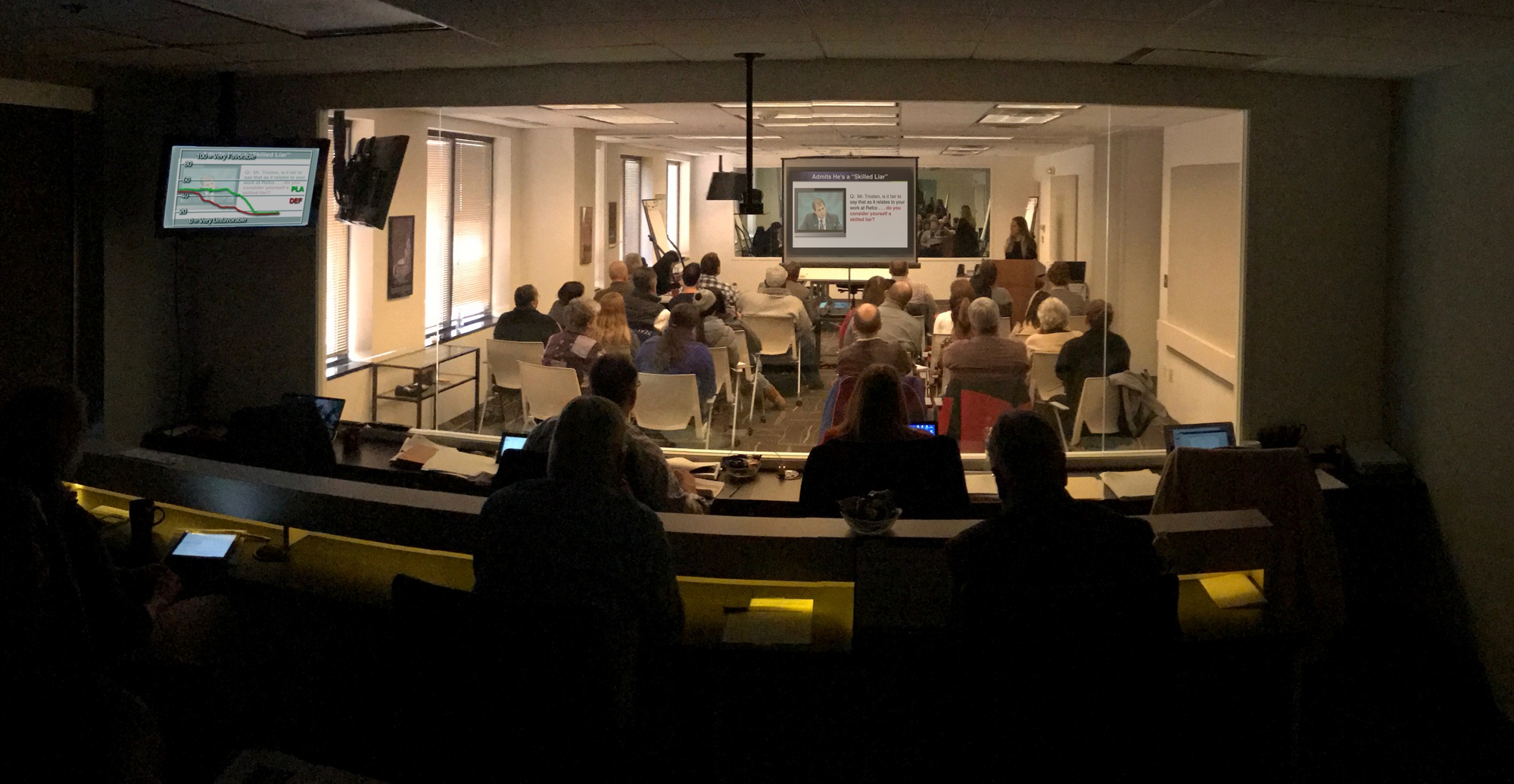Discover how optimizing mock trial graphics can lead to enhanced results in your trial. Explore the importance of testing trial graphics and learn how to create captivating visuals that make a lasting impact on the mock jury so you know how to speak visually to the trial jury.
Understanding the Power of Visuals in Mock Trials
Visuals play a crucial role in mock trials, as they have the power to convey complex information in a way that is easily understandable and memorable. By incorporating visuals into your trial, you can effectively communicate your arguments and evidence to the jury.
A well-designed visual can help simplify complex concepts, highlight key points, and reinforce your arguments. It can also engage the jury on a visual and emotional level, making your case more compelling and memorable.
Whether it's charts, graphs, diagrams, or animations, visuals can help jurors visualize the facts, understand the sequence of events, and grasp the overall context of your case. This understanding can significantly impact their perception and interpretation of the evidence presented.
Therefore, it is essential to understand the power of visuals in mock trials and utilize them strategically to enhance your chances of success.
The Role of Mock Trial Graphics in Captivating the Jury
Mock trial graphics play a vital role in captivating the mock jury and keeping them engaged throughout the mock trial. Jurors are more likely to pay attention and retain information when it is presented visually rather than through verbal arguments alone.
By utilizing mock trial graphics, you can create a compelling narrative that resonates with the mock jury. Visuals have the ability to evoke emotions, tell a story, and simplify complex information. They can help jurors connect with your case on a deeper level and make it more relatable.
Additionally, mock trial graphics can help you emphasize key pieces of evidence, highlight inconsistencies in the opposing party's arguments, and demonstrate cause-and-effect relationships. By presenting information visually, you can make it easier for the mock jury to understand and remember, increasing the likelihood of a favorable outcome.
In summary, mock trial graphics play a crucial role in captivating the mock jury and making your case more persuasive and memorable.
Testing and Refining Trial Graphics for Maximum Impact
Testing trial graphics is an essential step in optimizing their impact on the trial jury. By conducting mock trials or focus groups, you can gather valuable feedback and identify areas for improvement.
During the testing phase, observe how the mock jury interacts with the visuals and evaluate their comprehension and engagement levels. Pay attention to their reactions, questions, and overall understanding of the information presented.
Based on the feedback received, refine your trial graphics to enhance their clarity, effectiveness, and persuasiveness. This may involve simplifying complex visuals, adjusting the color scheme, or reorganizing the layout to improve readability.
By testing and refining your trial graphics, you can ensure that they have the maximum impact on the trial jury, effectively conveying your arguments and evidence.
Creating Engaging and Persuasive Visuals for Mock Trials
When creating visuals for mock trials, it is important to focus on making them engaging and persuasive. Consider the following tips:
1. Clearly define your objective: Determine the specific message or argument you want to convey through your visuals. This will help guide the design process and ensure that your visuals effectively support your case.
2. Keep it simple: Avoid cluttering your visuals with excessive information. Use clear and concise labels, headings, and captions to guide the jury's attention and understanding.
3. Use compelling visuals: Choose visuals that evoke emotions and create a connection with the jury. This can include photographs, illustrations, or animations that depict the key elements of your case.
4. Incorporate storytelling: Structure your visuals in a way that tells a cohesive and compelling story. Use a logical sequence to guide the jury through the evidence and arguments, building a persuasive narrative.
5. Test and iterate: As mentioned earlier, testing your visuals is crucial. Gather feedback, make necessary adjustments, and iterate until you have visuals that effectively communicate your message and engage the jury.
By following these guidelines, you can create engaging and persuasive visuals that leave a lasting impact on the jury.
Optimizing Mock Trial Graphics for Enhanced Results
Optimizing mock trial graphics is essential for achieving enhanced results in your trial. By following the steps mentioned above - understanding the power of visuals, utilizing mock trial graphics effectively, testing and refining trial graphics, and creating engaging visuals - you can maximize the impact of your visuals and significantly improve your chances of success.
Remember, visuals have the power to simplify complex information, evoke emotions, and create a memorable narrative. By optimizing your mock trial graphics, you can effectively convey your arguments, highlight key evidence, and captivate the jury throughout the trial.
In conclusion, invest time and effort in optimizing your mock trial graphics, as they can be a powerful tool in achieving the desired outcome in your trial.
Additional Persuadius articles related to mock trials, testing visuals, and trial prep include:
- 3 Critical Mock Trial "Clopening" Litigation Graphics Best Practices
- Why Litigation Graphics at Mock Trials Make Sense,
- Why You Should Pressure-Test Your Trial Graphics Well Before Trial,
- 7 Questions You Must Ask Your Mock Jury About Litigation Graphics, and
- Mock Trial Testing of Litigation Graphics AND Arguments.
- 10 Things Every Mock Jury Ever Has Said
- Mock Trials: Do They Work? Are They Valuable?
- Top 10 Articles About Mock Trials
- 5 Reasons Why Jury Consulting Is Very Important
- 6 Good Reasons to Conduct a Mock Trial
- 9 Things That Define the Best Litigation Graphics
- 11 Surprising Areas Where We Are Using Mock Exercises and Testing
- 7 Questions You Must Ask Your Mock Jury About Litigation Graphics
- 10 Suggestions for Conducting Mock Bench Trial Consulting Exercises
- Free Webinar: PowerPoint Litigation Graphics - Winning by Design™
- 13 Reasons Law Firm Litigation Graphics Departments Have Bad Luck
- Trending: Mock Trial Testing of Litigation Graphics AND Arguments
- 3 Observations by a Graphic Artist Turned Litigation Graphics Artist
- 21 Reasons a Litigator Is Your Best Litigation Graphics Consultant
- 6 Triggers That Prompt a Call to Your Litigation Consultant
- 11 Small Projects You Probably Don't Think Litigation Consultants Do
- 11 Things Your Colleagues Pay Litigation Consultants to Do
- 12 Reasons Litigation Graphics are More Complicated Than You Think
- Litigation Graphics: It's Not a Beauty Contest
- 11 Ways to Start Right With Your Litigation Graphics Team
- 16 PowerPoint Litigation Graphics You Won't Believe Are PowerPoint
- 13 Revolutionary Changes in Jury Consulting & Trial Consulting
- Presentation Graphics: Why The President Is Better Than You
- Using Litigation Graphics in Bench Trials: How Different Is It From Jury Trials?
- 12 Reasons Bullet Points Are Bad (in Trial Graphics or Anywhere)
- 5 Ways That a Mock Trial Informs and Shapes Voir Dire Questions
- Font Matters - A Trial Graphics Consultant's Trick to Overcome Bias
- 6 Studies That Support Litigation Graphics in Courtroom Presentations
- 8 Videos and 7 Articles About the Science of Persuasion
- Please Pretty Up These Litigation Graphics
- How Long Before Trial Should I Begin Preparing My Trial Graphics?
- Request a confidential conflict check from A2L Consulting now






Leave a Comment